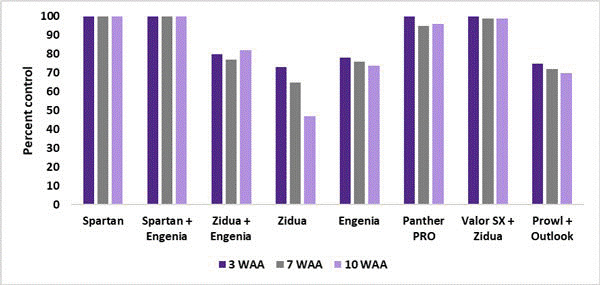This is the third and final article discussing pre-emergence herbicides for kochia control. This week, we will discuss recommendations specific to fields planted to soybeans, cotton, or sunflower this spring and wheat in the fall. Previous articles have discussed general considerations for late-winter kochia control (Issue 1037) and pre-emergence herbicides for kochia control in fields that will be planted to corn or grain sorghum (Issue 1038).
Fields going to soybeans
Start in February or early March with a tank mix of glyphosate (using a minimum of 0.75 lb ae/acre) or Gramoxone SL (minimum of 2 pts/acre) and 8 to 16 oz/acre of Clarity before kochia emergence. Clarity requires a minimum accumulation of 1 inch of rain and 28 days before planting soybeans, except for Roundup Ready 2 Xtend or XtendFlex soybeans. As indicated by the label, Clarity cannot be used as a pre-plant treatment in soybeans in areas with less than 25 inches of annual rainfall. Other dicamba-containing products may have different plant-back restrictions, so consult the label if using one of these products. Paraquat tank-mixed with metribuzin (Dimetric, others) will provide extended residual control of kochia as long as the kochia population is susceptible to triazine herbicides. Be aware of rate restrictions for metribuzin in western KS, as soil and environmental characteristics influence the potential for soybean injury following metribuzin.
Sulfentrazone-based products (Spartan, others) could also be considered for use prior to kochia emergence to manage an early flush. (Figures 1 and 2). However, it’s important to note the crop rotation restrictions on these products. Pyroxasulfone (Zidua) also has activity on kochia, although more rain is required for activation. Figure 1 illustrates the efficacy of various pre-emergence herbicide programs for controlling glyphosate- and dicamba-resistant kochia in Roundup Ready 2 Xtend soybeans planted in no-till dryland fields at Hays, KS. These treatments were applied to emerged kochia on May 23. All treatments also included Roundup PowerMax.

Figure 1. Kochia control following pre-emergence herbicide application in no-till dryland soybean in Hays, KS (WAA= weeks after application). Note that Engenia is not labeled for use in 2025; other dicamba formulations can be substituted. Data collected by Vipan Kumar, K-State Research and Extension.

Figure 2. Kochia control in non-treated plot (A) and with PRE applied Spartan (B) in Roundup Ready 2 Xtend soybean at 7 weeks after treatment (WAT). Photos by Vipan Kumar, K-State Research and Extension.
Fields going to sunflowers
Planting sunflowers into a clean seedbed is key to achieving good season-long control of all broadleaf and grassy weeds. But, it is especially important for getting good control of any weed populations, such as kochia, that are resistant to glyphosate or ALS-inhibiting herbicides and cannot be controlled with post-emergence herbicides in sunflowers.
The best approach to control ALS/glyphosate-resistant kochia in sunflower is to start in February/early March with a tank-mix of Gramoxone (using a minimum of 2 pts/acre) and Spartan, Spartan Charge (sulfentrazone+Aim), Broadaxe or Authority Elite (sulfentrazone+Dual Magnum), or Authority Supreme/Authority Edge (sulfentrazone+Zidua) before kochia begins to germinate. Select pre-emergence products effective on kochia and apply additional pre-emergence herbicides at planting to extend control of kochia and other weeds. Dicamba is not an option in these applications due to label restrictions. Monitor fields closely, as additional Gramoxone SL treatments may be required before sunflower planting.
Fields going to cotton
Effective kochia control in cotton often requires a pre-plant application two to three months ahead of the typical May planting. Dicamba (Banvel, others) plus flumioxazin (Valor, others) applied in February prior to kochia emergence can be effective, and any cotton variety can be planted 30 days after application. Prometryn (Caparol) is also an option with some preemergence kochia activity, but a 12-month recropping restriction exists for all crops other than cotton (anytime) and corn (5 months). Should a burndown of kochia become necessary, Gramoxone should be used, along with an approved tank-mix partner such as Caparol, Cotaran (fluometuron), or Karmex (diuron).
Fields going to fall-planted wheat
If kochia is emerging in fields to be planted to wheat this fall, atrazine cannot be used. Metribuzin can be substituted for atrazine and has a 4-month plant-back restriction for wheat. Additional products include Scoparia, Authority MTZ, and products containing sulfentrazone or isoxaflutole. Zidua also has good activity but requires significant rainfall for activation, so it should be applied with dicamba.
Consult the 2025 K-State Chemical Weed Control Guide (SRP 1190) for more information on controlling kochia: https://bookstore.ksre.ksu.edu/item/2025-chemical-weed-control-for-field-crops-pastures-rangeland-and-noncropland_SRP1190
The use of trade names is for clarity to readers and does not imply endorsement of a particular product, nor does exclusion imply non-approval. Always consult the herbicide label for the most current use requirements.
Sarah Lancaster, Weed Management Specialist
slancaster@ksu.edu
Jeremie Kouame, Weed Scientist – Agricultural Research Center, Hays
jkouame@ksu.edu
Patrick Geier, Weed Scientist - Southwest Research & Extension Center, Garden City
pgeier@ksu.edu